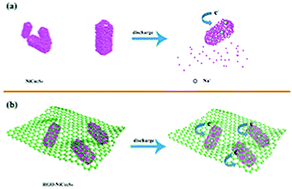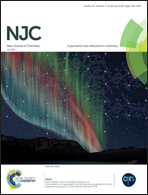Hollow prism NiCo2S4 linked with interconnected reduced graphene oxide as a high performance anode material for sodium and lithium ion batteries†
Abstract
A new type of hierarchical reduced graphene oxide wrapped NiCo2S4 composite composed of a reduced graphene oxide (RGO) matrix and a hollow prism of NiCo2S4 with a typical size of 500–600 nm is developed and investigated as an anode material for Li-ion and Na-ion storage. The hollow NiCo2S4 prisms consisting of interconnected nanoparticles possess a lot of pores, providing a sufficient electrode/electrolyte contact area, as well as acting as cushion spaces for the huge volume changes during the discharge–charge processes. The three-dimensional RGO backboned matrix not only acts as a confinement layer to prevent the NiCo2S4 nanoparticles from aggregating during preparation of the material, but also functions as a physical barrier to buffer the volume change effects during the charge/discharge processes. As a consequence, the composite demonstrates excellent rate performance and cycling stability for both Li-ion and Na-ion storage. In particular, the RGO–NiCo2S4 anode exhibits an impressive reversible capacity of 903 mA h g−1 after 80 cycles at 500 mA g−1 and a high rate capacity of 489.3 mA h g−1 even at 1600 mA g−1 for Li-ion storage. Moreover, a reversible Na-ion storage capacity of 530.2 mA h g−1 with negligible fading is also achieved after 70 cycles at 50 mA g−1. When the current density is increased to 800 mA g−1, the RGO–NiCo2S4 anode still obtains a discharge capacity of 220 mA h g−1.



 Please wait while we load your content...
Please wait while we load your content...